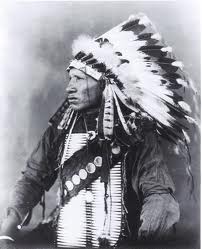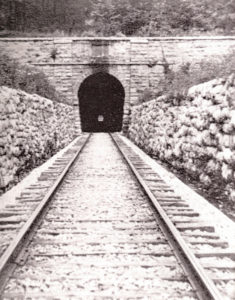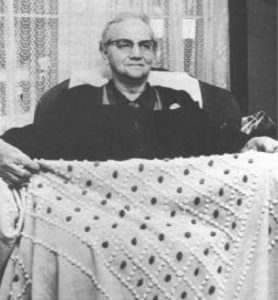
Chief Redbird of the Cherokee Nation who controlled the areas that became Hamilton’s Spring.
The Cherokee
Before Dalton was established under its first name, Cross Plains, Creek and Cherokee Native Americans had inhabited this land for generations, calling the North Georgia area “The Enchanted Lands” because of the rich beauty and their spiritual connection to the land. However, in the late 1700s, American settlers began pushing west and setting up new towns along the way. In the Mid 1700s, the Creek and Cherokee Nations fought over the land now known as Dalton. The Cherokee won the war and lived in the area peacefully until the 1830’s when they were forced by the United States Government to leave their lands during the Trail of Tears.
The Trail of Tears began just north of Dalton in Red Clay, Tennessee. The Trail led through Tennessee, Alabama, Kentucky, Mississippi, Arkansas, and finally into Oklahoma. 13,000 Cherokee embarked on the 1,000-mile journey, leaving the Enchanted Land behind.

The Western & Atlantic Railroad tunnel built by hand through the Chetoogetta Mountian in Tunnel Hill was the last major construction project that linked the railroad from Chattanooga to Atlanta.
The Railroad
In the 1840s plans were drawn up by the Western & Atlantic Railroad to connect the Tennessee River with the Georgia Railroad. Construction of the railroad began in 1848, and the final segment of this pivotal railways was completed with the famous Railroad Tunnel that goes through the Chetoogeta Mountain in Tunnel Hill, Georgia. The railroad became one of the most important industries in Dalton throughout the 1850s. The railroad provided businesses the transportation tools they needed to transport their products across state bounds. In Dalton, the number one industry in the 1850s was cotton.
Cotton was transported to the rest of the country via the railroad in Dalton and provided. Soon new settlers would come, build houses, start businesses, and provide even more economic stability for Dalton. In 1847, the Western & Atlantic Depot was constructed in Dalton and became a pivotal stopping location for travelers and industry alike. The Dalton Depot still stands today.
The Civil War
Dalton is packed with Civil War sites and related history. In fact, the United States Government recently declared Dalton and Whitfield County to have more intact Civil War artifacts than any other place in the country. On April 12th, 1862, volunteers from the Union Army under the command of James J. Andrews, took control of a train located at Big Shanty (now Kennesaw, Georgia). The Train was normally set to run from Kennesaw to Chattanooga and would pass through Dalton along the way. Confederate Soldiers gave chase, and briefly stopped in Dalton at the Depot to signal ahead, and warn confederate soldiers stationed along the railroad what had happened. The stolen train, called the General, passed through the Railroad Tunnel at Tunnel Hill and made it as far as Ringgold before being captured. James J Andrews was tried in a military court and found guilty. He was hung on June 7th, 1862 in Chattanooga, Tennessee, along with seven others who participated in the Great Locomotive Chase.
In 1863, after the battles of Chickamauga and Chattanooga, Confederate Soldiers, beaten and battered, retreated to Dalton to find refuge. General Joseph E. Johnson, commanding officer of the Confederate Army in Georgia, took up headquarters at the Huff House, still standing today. By spring of 1864, Union forces began a campaign to drive the Confederate Army south, towards Atlanta. Two battles occurred in the area; one at Rocky Face Ridge, and the other at Dug Gap Mountain. Neither battle were major engagements, but they did cede the city of Dalton to Union Forces under command of Major General William T. Sherman. The earthwork formations used in the defense are still present on Dug Gap Mountain and Rocky Face Ridge.
After the Civil War and during the Reconstruction, Dalton, like most towns in the south, struggled economically. The economic depression of the late 1800s lasted until the early 1900s when a new hope emerged.
The Textile Industry
In 1895, a young teenage girl named Catherine Evans Whitener made her brother, and his new bride, a unique gift, one that would forever change the course of Dalton’s history. The gift was an unusual tufted bedspread that Catherine had sewn herself. Catherine continued to make the Chenille bedspreads for her friends and family. In the early 1900’s she sold her first bedspread to a socialite for $2.95. The craze caught on, and people from all over the US wanted the unusually tufted Chenille Bedspreads. Dalton is affectionately called the Carpet Capitol of the World these days, but before WWII Dalton was known as the Bedspread Capital of the world. Many families in the area worked in the tufting industry or were haulers, an early form of truck delivery. Income generated by the tufting industry helped Dalton overcome the economic hardships from the post-Civil War era but also helped Dalton throughout the Great Depression.
After WWII, a form of mechanized carpet was developed, and because Dalton had an excess of people with tufting skills, the carpet industry took off in this area. Since the 1970s, 90% of the world’s carpet is made right here in Dalton and surrounding areas. The Industry employs over 30,000 people in Whitfield County alone, clearly giving Dalton the distinction of The Carpet Capital of the World.

Dalton is a vibrant community, full of stunning natural beauty, rich cultural history and a modern flair that is truly original.
Today
In addition to the carpet and now flooring industry, Dalton has a growing arts community. The Creative Arts Guild in Dalton is one of the oldest Arts Guilds in Georgia. The area is producing a lot of talented musicians who play music from a wide range of genres, such as Country, Blues, and Americana. Dalton is an ideal location in the Georgia Mountains for hiking, biking, fishing, hunting, camping, kayaking and more. There is also a delightful downtown with numerous boutiques for a unique shopping experience and locally-owned restaurants, bars, taverns, breweries and even a moonshine distillery, with unforgettable fare and atmosphere.





